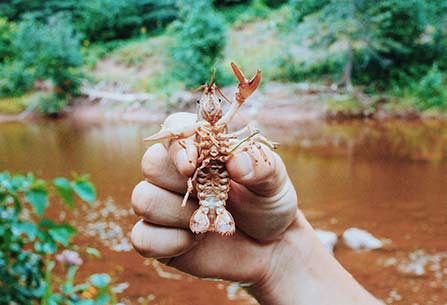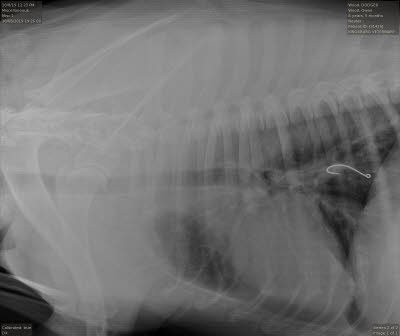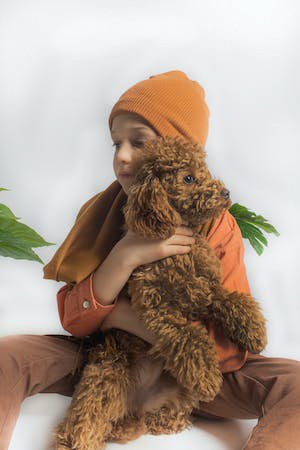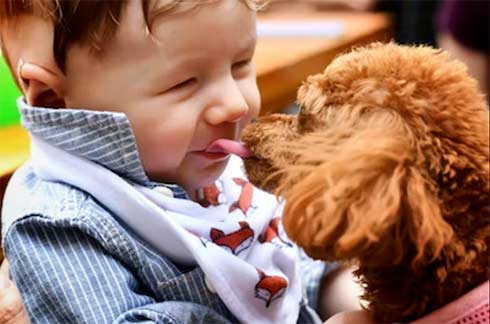Crawdad Fishing–What (who) they Caught
I’d arrived home, made myself dinner (at that point in my life it might have been of the TV variety), and was starting to unwind when my pager beeped. We had those electronic leashes before there were cell phones and emergency clinics. (I had a love-hate relationship with my pager. Mostly hate) I called the answering service, scribbled down the phone number and a brief description of the problem. A dog had swallowed a fish hook. Uh oh. I called the distressed mother of 3 young children and told them to meet me in 10 minutes.
“Princess” had been crawdad fishing with the kids on a North valley irrigation ditch near their home when a fishhook, baited with chicken fat, swung past this miniature poodle’s nose. Dogs, I remind you, are scavengers of the highest order – even those whose ears are festooned with pretty bows. If it resembles food, however gross, it has to be consumed ASAP.
On the exam table Princess wore a morose expression while making a series of gulping motions. A few inches of fishing leader dangled from the corner of her mouth. Chest x-rays showed the offending fishhook lodged mid-esophagus, just behind this girl’s heart. Had it found its way to her stomach we might have been able to retrieve it with the endoscope but it had stopped cold where the barb dug in. It wasn’t going anywhere. Any attempt to tug it loose would have risked tearing a hole that would leak food and bacteria into Princess’s chest. Death would follow that mistake.
Removing this ticking time bomb meant opening a space between Princess’s ribs and packing off her lungs before incising her esophagus. Thoracic surgery is not a one-person job. Once a chest is open, air cannot be sucked in and exhaled without assistance. I called Amos.
This highly dedicated young man would do anything I asked, well, almost anything. This particular evening, my seldom-socially-engaged assistant was entertaining a young lady. It was a big night for him. I explained that open chest surgery would be the only way to help this special dog. Her children were in tears. Amos had never been part of a thoracic procedure. He was on his way in minutes.
Catch & Release
A lot of important stuff happens in our chests. Adding a fishhook is not a positive. We premedicated Princess with a pain reliever and sedative, administered IV anesthetic, passed a tube into her trachea (windpipe), and started oxygen and gas anesthesia. Her vital signs were strong. So far, so good.
Amos did a thorough prep of our patient’s chest and then wheeled her into surgery. After scrubbing, gowning and gloving, I was ready to make the incision between Princess’s ribs. Her breathing over the next hour would be carefully managed by my assistant’s gentle hands on the anesthetic breathing bag. I opened the chest and said “breathe.” After inserting the retractor, I said “breathe.” Then I packed off the lungs with warm saline-soaked lap sponges, first on one side and then the other, and repeated “breathe.” It was a careful, well-communicated dance.
I felt a lot better when I saw and then palpated the hard lump lodged in the wall of Princess’s esophagus. There was no sign of a perforation. I just needed enough space to remove the offending foreign body without causing further damage. The admonishment of the ancient Greek physician Hippocrates to “first do no harm” weighed heavily. I took it slow.
With irrigation and suction at the ready, I made a small incision just behind where the fishhook was lodged, reached inside with a curved Kelly forceps and gently maneuvered it. And it came free. Using the warm saline Amos added to a sterile bowl, while he continued breathing for our girl – on my cue, I rinsed and suctioned the esophagus and securely sutured it.
Open chest procedures don’t end when the ribs are closed. A final squeeze of the breathing bag will force much of the free air out just as the last stitch in the skin is placed but there is always more that’s left behind. I’d inserted a chest tube with a one-way valve. The suction machine withdrew more free air. All good? Not so fast.
Human Suction Machine
The term free air may conjure filling stations of old, where you could pull up to the compressor and inflate your tires. Free air in a chest means that it’s not in the lungs where it belongs, keeping us alive; it’s outside the lung lobes but trapped within the chest cavity. Princess wouldn’t be able to breathe against that potential complication. But by inflating her lungs as I closed her ribs, followed by chest tube suction, we would eliminate this problem. As I set down my instruments I asked Amos to switch off the oxygen. That’s when our sleeping patient immediately began to struggle, inhaling only small amounts of air. The color of her gums was quickly turning a pale purple. We had no pulse oximeters in the ‘80s. Visual monitoring told the tale. Princess’s blood oxygen was dropping like a stone.
We had to remove the trapped free air – right now. I heard a moan and glanced at my normally steadfast assistant and saw a look of horror. “No need for panic, Amos” I said in my most soothing tone. “This shouldn’t be difficult,” whereupon I hefted our 15# patient with both hands and popped the end of her chest tube into my mouth.
My first suck produced nothing so I rotated our poodle, as though she were a pig on a spit, and sucked again. I was immediately rewarded by a mouthful of air – most gratifying. I turned Princess again and sucked – a bit more air. We were on a roll. I tipped her horizontally, vertically, upside down, and at every angle possible. As the free air moved above the horizontal, the tip of the chest tube tapped into a different pocket. When my repeated sucking finally gave up nothing I set our patient back on the table and – she breathed just like a normal dog. As I gazed admiringly at the natural beauty of her lovely pink gums, I breathed the words, “Sorry for the drama, girl.” Then I looked at Amos and saw a young man who was nearly comatose himself. I barked, “Amos! She’s fine!” My faithful nurse recovered his composure quickly.
Voodoo Veterinary Medicine?
Work flow during the infant months of my veterinary practice was intermittent but with time we got busier. Martha needed help at the desk. In the treatment area I’d become concerned about Amos’ increasingly frantic demeanor. He felt that he could only keep up if he moved faster and faster. So I hired Kendra Franklin, a promising young woman, who turned out to be – interesting. But beyond our new staff training responsibilities it was Princess, the fishhook-swallowing poodle, who remained priority one.
When I was satisfied that our surgery patient was stable I called Mom, Dad, and the kiddos from my desk. I shared the good news that we expected their pupster to make a full recovery but that we would need to monitor her for a couple more days. Their curly-coated girl was ready for visitors; the offending foreign body was ready for their scrapbook.
After finishing the call it was time to chart the evening’s adventure in Princess’s medical record. I pulled open the top drawer of my desk to reach for a pen and found more than a writing instrument. Staring up at me was a carefully constructed effigy of, well, me. Complete with bushy hair and moustache, along with the requisite straight pin through my middle, this was an unusual expression of – office politics?
I relish challenging cases. It’s hard work but improving lives, sometimes saving them, keeps me motivated. It was my years as a veterinary hospital owner where I found the staff management side of my job to be a lot more difficult. When it was good it was very good; when it was bad it was horrible. In school they didn’t teach us about voodoo or negotiating the distractions of pranks and hexes. I was at a loss.
I’d been feeling pretty confident in my leadership skills, working with Martha and Amos so, when we added Kendra, I expected more of the same. Silly me. It could have been worse. If our new hire was behind the mystery poppet her subterfuge was a failure; I did not pitch over from a mind-bending stab of chest pain.
Where should I draw the line? I could accept a wiccan on my staff but leaving cryptic surprises in my desk presented a management dilemma. Install surveillance cameras? (Not in the ‘80s) Call Dick Tracy?
Princess Good; Knives & Dummies Bad
Who doesn’t love reunions? Princess needed to stay quiet the day after her open chest surgery but she and her family had never been happier. They gratefully accepted the fishhook she’d swallowed, promising to return the next day to keep their pupster’s spirits up.
Free air was minimal, Princess’ lung sounds were good, her respirations normal. So I took the plunge on day 3 and removed her chest tube. She ate well, felt great, and went home with strict instructions for minimal activity.
I’d called Dick Tracey for help with my other pressing dilemma but, sadly, his Apple Watch must have lost its charge. I was on my own. It might have been unfair to suspect our new staff member, rather than Amos or Martha, of planting that annoying voodoo doll in my desk but all doubt evaporated a few weeks later when Kendra displayed a pointed instrument of her purported pagan rituals.
I know I can be a stick-in-the-mud but show and tell with a blood gutter knife – in the workplace? How about weapons or drama of any sort? I didn’t think so either. Risking a hex, I invited Kendra for an open-door chat in my office. I explained that blades and hidden dummies were not part of our workplace culture. She left in a quiet huff. There was no string of bad luck although I think there would have been had she stayed.
On a follow-up exam two weeks later I released Princess to engage in normal poodle activities. Her family’s 5 year old boy explained that they were planning another crawdad fishing expedition and asked if their dog would have learned her lesson about filching chicken fat from a fishhook. I was kind but firm: Princess was a true scavenger, a strict adherent to Murphy’s Law: Anything that could go wrong in a pet’s behavior certainly would. No more fishing for this fuzzy cream puff.
I occasionally wondered whether our erstwhile attention-seeking employee would resurface, until I received a call from a CIA officer requesting a meeting. I was told about whom but not why. It did not occur to me to refuse the invitation.
Workplace antics and the CIA
I’m residency trained in veterinary behavior medicine; I have no business venturing into the brains of humans. But, in this case, I did it anyway. Looking back on Kendra, it was clear that our effigy planting, blood gutter knife displaying, wicca enthusiast, short-term employee arrived with her own agenda. I don’t believe she was proselytizing her spiritual inclinations; she simply reveled in stirring the pot for personal amusement. She was good with clients at the desk and helpful in caring for pets like Princess, the fishhook swallowing poodle, but her shenanigans had become a serious distraction.
Owning a veterinary hospital was harder work, requiring greater multitasking skills, than I ever imagined. The dogs and cats in our care surely have better outcomes if the entire staff stays focused. After Kendra stalked out the door we heaved a collective sigh of relief, Amos and Martha wondering aloud, “Who would want to hire somebody like that?” Then the CIA arrived.
The agent was punctual and impressive. Clad in a snappy navy blue uniform, sporting a shiny badge and rather conspicuous heat on her belt, her appearance was arresting. She proffered her business card, took a seat in my office, and got right down to business. Kendra Franklin had applied to the agency for employment.
Hoping that this no-nonsense official was a fellow pet lover I tried hoisting a feelgood anecdote up the flagpole, recounting the story of Princess and her excellent family. My friendly overture was waved off like so much fluff. The officer immediately drove hard into her questions. I shared Kendra’s good points but felt the need to be thorough and completely honest. My recounting of the unsavory episodes was met with disbelief. “Well,” I replied, “I am a taxpayer and a US citizen. We need mature, competent personnel in the CIA. I don’t recommend Kendra for intelligence work.” My interviewer left in a quiet huff.
I was now free to return to my real work. I spayed a dog and a cat, treated a case of vomiting, and consulted on a dog with separation anxiety. I really love veterinary practice, well, most of it anyway.







